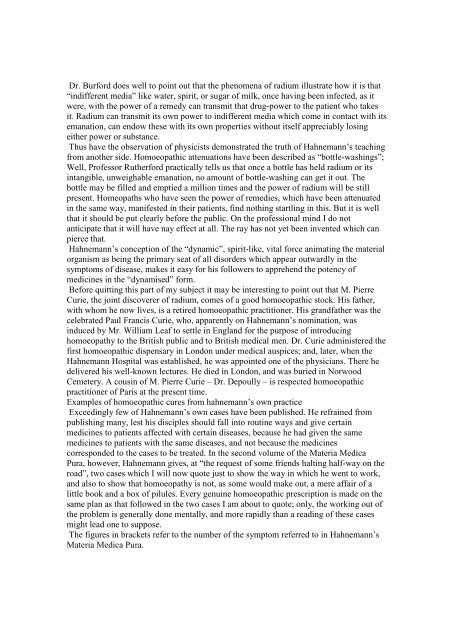CLARKE JH, Homoeopathy Explained - Classical Homeopathy Online
CLARKE JH, Homoeopathy Explained - Classical Homeopathy Online
CLARKE JH, Homoeopathy Explained - Classical Homeopathy Online
You also want an ePaper? Increase the reach of your titles
YUMPU automatically turns print PDFs into web optimized ePapers that Google loves.
Dr. Burford does well to point out that the phenomena of radium illustrate how it is that<br />
“indifferent media” like water, spirit, or sugar of milk, once having been infected, as it<br />
were, with the power of a remedy can transmit that drug-power to the patient who takes<br />
it. Radium can transmit its own power to indifferent media which come in contact with its<br />
emanation, can endow these with its own properties without itself appreciably losing<br />
either power or substance.<br />
Thus have the observation of physicists demonstrated the truth of Hahnemann’s teaching<br />
from another side. Homoeopathic attenuations have been described as “bottle-washings”;<br />
Well, Professor Rutherford practically tells us that once a bottle has held radium or its<br />
intangible, unweighable emanation, no amount of bottle-washing can get it out. The<br />
bottle may be filled and emptied a million times and the power of radium will be still<br />
present. Homeopaths who have seen the power of remedies, which have been attenuated<br />
in the same way, manifested in their patients, find nothing startling in this. But it is well<br />
that it should be put clearly before the public. On the professional mind I do not<br />
anticipate that it will have nay effect at all. The ray has not yet been invented which can<br />
pierce that.<br />
Hahnemann’s conception of the “dynamic”, spirit-like, vital force animating the material<br />
organism as being the primary seat of all disorders which appear outwardly in the<br />
symptoms of disease, makes it easy for his followers to apprehend the potency of<br />
medicines in the “dynamised” form.<br />
Before quitting this part of my subject it may be interesting to point out that M. Pierre<br />
Curie, the joint discoverer of radium, comes of a good homoeopathic stock. His father,<br />
with whom he now lives, is a retired homoeopathic practitioner. His grandfather was the<br />
celebrated Paul Francis Curie, who, apparently on Hahnemann’s nomination, was<br />
induced by Mr. William Leaf to settle in England for the purpose of introducing<br />
homoeopathy to the British public and to British medical men. Dr. Curie administered the<br />
first homoeopathic dispensary in London under medical auspices; and, later, when the<br />
Hahnemann Hospital was established, he was appointed one of the physicians. There he<br />
delivered his well-known lectures. He died in London, and was buried in Norwood<br />
Cemetery. A cousin of M. Pierre Curie – Dr. Depoully – is respected homoeopathic<br />
practitioner of Paris at the present time.<br />
Examples of homoeopathic cures from hahnemann’s own practice<br />
Exceedingly few of Hahnemann’s own cases have been published. He refrained from<br />
publishing many, lest his disciples should fall into routine ways and give certain<br />
medicines to patients affected with certain diseases, because he had given the same<br />
medicines to patients with the same diseases, and not because the medicines<br />
corresponded to the cases to be treated. In the second volume of the Materia Medica<br />
Pura, however, Hahnemann gives, at “the request of some friends halting half-way on the<br />
road”, two cases which I will now quote just to show the way in which he went to work,<br />
and also to show that homoeopathy is not, as some would make out, a mere affair of a<br />
little book and a box of pilules. Every genuine homoeopathic prescription is made on the<br />
same plan as that followed in the two cases I am about to quote; only, the working out of<br />
the problem is generally done mentally, and more rapidly than a reading of these cases<br />
might lead one to suppose.<br />
The figures in brackets refer to the number of the symptom referred to in Hahnemann’s<br />
Materia Medica Pura.
















